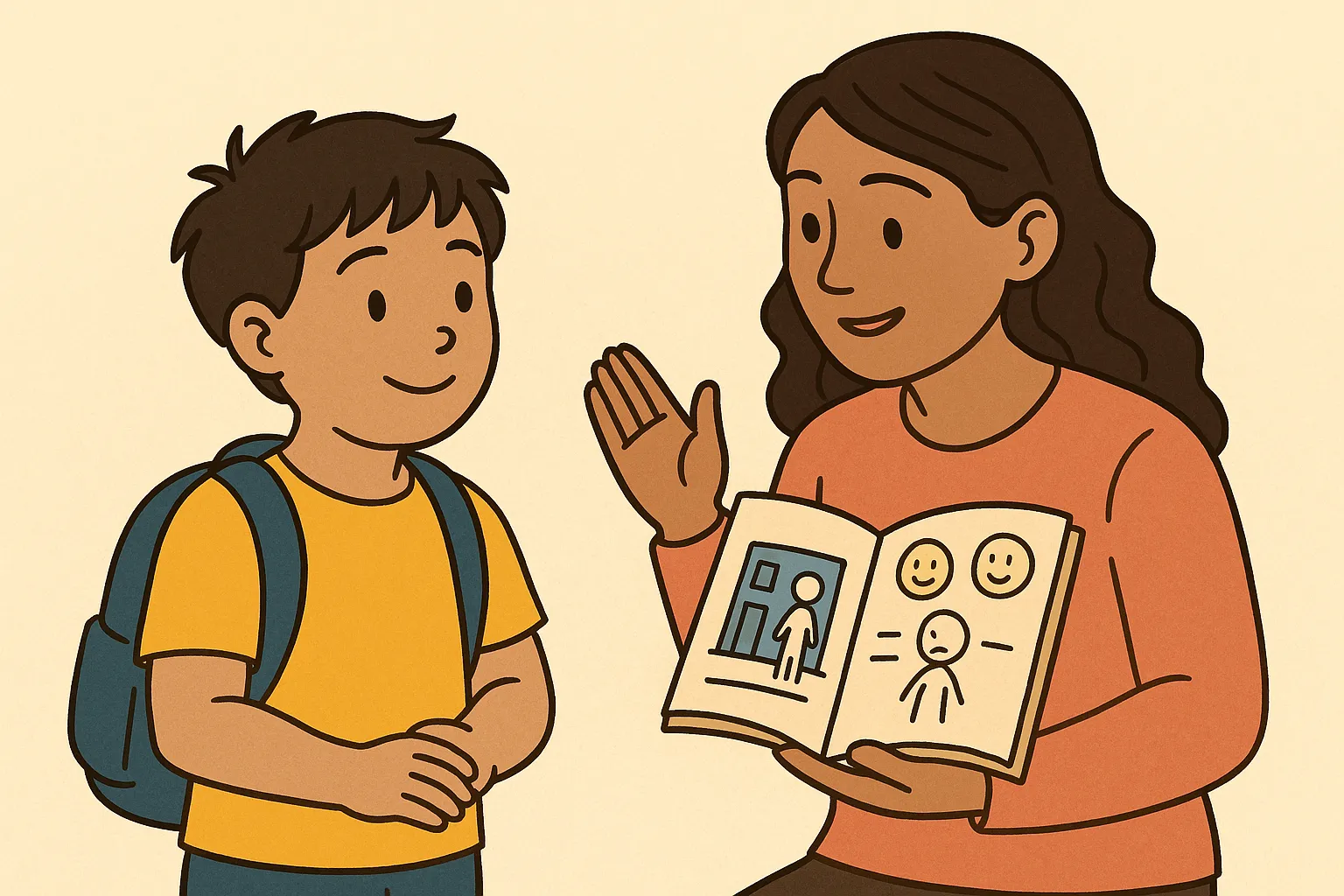What to Do After Your Child’s Autism Diagnosis
What to Do After Your Child’s Autism Diagnosis

What to Do After Your Child’s Autism Diagnosis- 5 Steps to Take
Hearing the words “your child has autism” can bring a mix of emotions: relief at finally having an explanation, uncertainty about the future, and questions about what to do next. You are not alone. Many families feel overwhelmed after a diagnosis, but taking deliberate steps early can make a meaningful difference in your child’s development. This guide walks you through five practical steps to take immediately after a diagnosis, what to expect as services begin, and ways to support your child at home. It is designed to help parents feel informed, organized, and empowered to navigate the next chapter in their child’s care.
5 Steps to Take Right After an Autism Diagnosis
1. Schedule a follow-up with your child’s doctor
Your pediatrician is your first partner in planning the next steps. Schedule a dedicated follow-up appointment to review the diagnostic report in detail and discuss therapy options such as speech, occupational, and Applied Behavior Analysis (ABA). Sample questions to bring include, what should we prioritize first, which therapies do you recommend, are there any urgent developmental concerns like feeding or sleep we should address now, and can your office run an insurance benefit check for autism services. Ask for specific referrals, and request the name and contact for a referral coordinator or social worker if available. If the pediatrician recommends additional testing, such as hearing or vision screens, ask how to schedule those and whether they must happen before therapy begins. Leave the appointment with at least two next steps you can act on that week, for example, three provider phone numbers to call and the referral or authorization needed to start intake.
Ask about any additional evaluations that may be needed, including hearing, vision, or developmental screenings. Request referrals to specialists, and ask your pediatrician’s office to run an insurance benefit check to confirm coverage for autism-related services. Clarifying priorities, next steps, and timelines with your pediatrician ensures you have a structured plan and can start therapies promptly without unnecessary delays.
2. Contact Early Intervention or your local school system
If your child is under three, call your state’s Early Intervention (EI) program under Part C of IDEA to request services. If your child is three or older, contact your local school district to request a special education evaluation that can lead to an Individualized Education Program (IEP).
Submit your request in writing with your child’s name, date of birth, diagnosis, and a clear statement requesting evaluation so you have a record. A short email can read, “I am requesting a special education evaluation for [child’s name], DOB [date], due to a recent autism diagnosis. Please confirm the next steps.” Response timelines vary by state, typically within 10 to 60 days, so ask your district for its specific deadline (Schools are legally required to respond within a set timeline, state dependent). When you call or email, ask how evaluations are conducted, whether services are provided at school, at home, or in clinic settings, and what documentation they require. Request a copy of any parent consent forms in advance so you can submit paperwork promptly. For differences in therapy settings and how they affect families, see our in-depth comparison see in-home vs. clinic-based ABA.
3. Begin intake calls for recommended therapies
Therapy waitlists can last weeks or months, so start calls right away. Waitlists can last weeks or months, so add your child to multiple lists and ask each clinic about cancellations lists or short intake consults. When you call, record the intake steps, required documents, whether the clinic accepts your insurance, whether prior authorization is needed, current wait time, and whether telehealth, home-based, or clinic-based services are available. Core therapies include:
- Applied Behavior Analysis (ABA) for skill-building and behavior support
- Speech-language therapy for communication and social skills
- Occupational therapy (OT) for fine motor, sensory, and daily living skills
Ask if a Board Certified Behavior Analyst or supervising clinician reviews treatment plans. If cost is a concern, ask about sliding scale fees, community clinics, or nonprofit programs. Track every provider contact in one document so you can compare options quickly. For background on available therapies and what to expect from each, see our guides at https://www.alpacahealth.io/blog/autism-spectrum-therapies-guide, https://www.alpacahealth.io/blog/speech-therapy-autism-guide, and https://www.alpacahealth.io/blog/what-is-aba-treatment-autism.
4. Review your insurance plan and available funding
Insurance coverage varies widely. Call your insurer and request a benefit check for autism-related therapies. Ask exactly which services/therapies are covered, whether prior authorization is required, if there are session limits or age restrictions, what documentation is required such as the diagnostic report or medical referral, and how to submit claims. Ask your pediatrician’s office if they will run the benefit check with you or submit documents directly.
Beyond private insurance, research Medicaid eligibility, state autism waivers, and local grant programs for additional funding. Search “[Your State] autism waiver” to find state-specific information and application steps. Understanding coverage early ensures you can schedule services without financial surprises. Keep a folder of all insurance communications, authorization numbers, and claim confirmations so you can reference them during appeals or later authorization renewals.
5. Create an organized system for documents and tasks
Autism care involves multiple providers, reports, and schedules. Start a binder or digital folder with sections for: diagnostic report, medical records, therapy notes, IEP or EI documents, insurance, and provider contacts. Items to keep: the full diagnostic report, any referrals, test results, IEP or EI plans, insurance approvals, provider intake forms, and session summaries.
Use a simple tracker to log provider names, phone numbers, waitlist status, authorization dates, and next steps. Tools like Google Drive, Notion, or Trello work well for families who want digital access across devices. Consider a printable checklist for things to gather and tasks to complete, such as request EI or school evaluation in writing, call three providers, and request a benefit check. A consistent system saves time and strengthens your ability to advocate for services.
What to Expect After Starting Autism Services
Once services begin, progress is usually gradual but measurable. Providers set individualized goals, and you may notice improvements such as new words, smoother transitions, increased attention span, or reduced frustration.
Expect regular progress reviews every few months to assess milestones, adjust strategies, and set new objectives. Roles may shift over time, with new therapists joining or goals being updated to reflect your child’s development. Keep detailed notes on achievements and strategies that work at home. Celebrating small wins and maintaining open communication with your care team helps stay engaged and confident in the ongoing process.
How to Support Your Child at Home After an Autism Diagnosis
You do not need to replicate therapy at home. Focus on creating a predictable, calm, and supportive environment. SOme ideas include:
- Visual schedules
- Use picture boards or timers for daily routines and transitions
- Use picture boards or timers for daily routines and transitions
- Sensory-friendly spaces
- Provide quiet areas, soft lighting, noise-canceling headphones, or fidget tools
- Provide quiet areas, soft lighting, noise-canceling headphones, or fidget tools
- Clear communication
- Use short, simple instructions with visual or gestural cues
- Use short, simple instructions with visual or gestural cues
- Consistent routines and positive reinforcement
- Celebrate small achievements to build confidence
- Celebrate small achievements to build confidence
These strategies help reduce stress, improve engagement, and allow your child to practice skills in a familiar setting. For guidance on communicating your child’s diagnosis to relatives, see talking to extended family.
Learning More About Autism and Advocating for Your Child
Continued learning empowers you to make informed decisions. Seek credible sources such as the CDC, Autism Navigator, or local parent advocacy groups (especially on Facebook). Understanding your child’s strengths and challenges allows you to advocate effectively in schools, medical appointments, and community settings. Keep track of questions, progress, and services in writing, and don’t hesitate to request clarifications or additional support.
FAQs: What to Do After an Autism Diagnosis
What should I do first after my child is diagnosed with autism?
Schedule a follow-up with your pediatrician. Bring your diagnostic report, a list of questions, and discuss any developmental concerns. Ask about therapy referrals, insurance coverage, and guidance on prioritizing services.
How do I get autism therapy started now that my child is diagnosed?
Start intake calls for ABA, speech, and occupational therapy as soon as possible. Join multiple waitlists and confirm required documents and start dates. Platforms like Alpaca Health can be used to locate providers efficiently.
What paperwork do I need to get services after diagnosis?
Most providers require the diagnostic report, pediatric referral, and insurance information. Schools will also need a written evaluation request for IEPs. Keep copies organized for easy access.
Should I tell my child’s school about the diagnosis?
Yes. Providing the school with your child’s diagnosis allows evaluation for special education services, accommodations, and therapy support to begin promptly. Early communication can speed access to services.
How can I track my child’s progress once services begin?
Request regular progress reports from providers and keep a log of achievements at home. Note new skills, improved routines, or social gains. This helps you and your care team measure growth and adjust support plans as needed.
How does Alpaca Health support families on this journey?
Alpaca Health connects families with ABA therapy providers and simplifies care coordination. Our platform helps track schedules, monitor progress, and find the right provider for your child. Families just starting their journey or seeking evaluations can explore our services to take the next step with confidence.
High Quality, Local ABA
If you are ready to partner with a local BCBA and receive the highest quality of care, reach out today!







